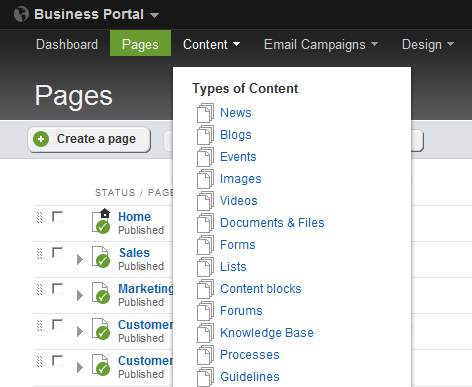Intranet Requirements and Fundamentals

The purpose of an Intranet is to enable an organization to share knowledge, communicate, collaborate, and enable it to do more than it did yesterday. Specific intranet CMS requirements can vary significantly based on different factors, such as organization type, business processes, culture, goals, scope, etc. These requirements usually fall into three fundamental categories: knowledge management, communication coupled with collaboration, and line of business applications.
When conceiving your Intranet, a good place to start is to consider its fundamentals —key intranet functions (requirements), goals, and stakeholders. After mastering the fundamentals, you can then examine the more specific needs of organizational teams and stakeholders. Let’s take a closer look at the three fundamental intranet requirements.
Knowledge Management
It is critical for an organization to effectively capture, manage, and share knowledge that its people create. It is a never ending process of transforming tacit knowledge into explicit knowledge. That process provides organizations with the ability to learn from past experiences and address tomorrow’s challenges without repeating mistakes of the past.
Organizational knowledge comes in various forms and types. As fundamental content types, we can consider the following:
- Guidelines
- Processes
- Knowledge base articles
- Documents and files
- Videos
- Events
- Books
Once the intranet accumulates enough information, a convenient search function becomes an essential element. That way, staff have a convenient method to seek and access desired information.
Sitefinity offers some of the above content types out of the box, and enables users to easily create the others types using the awesome Module Builder feature. Sitefinity also offers a powerful built-in search based on the Lucene search engine.
Communication and Collaboration
In addition to knowledge management, an intranet should also facilitate communication and collaboration between individuals, various stakeholders, and teams across an organization. Some fundamental intranet requirements in this category are:
- Ability to post announcements and communicate information via:
- News articles
- Blog posts
- Internal newsletters
- Ability to comment on articles as well as engage in a discussion about an idea or given topic
- Ability to subscribe to relevant RSS feeds for content updates
Sitefinity has a built-in Forums module that is great for internal discussions. There are also news, blogs, newsletters, RSS feeds, comments, and more that are available to use on an Intranet.
Line of Business Applications
Organizations rely on various desktop and web applications to facilitate day to day operations. These include data collection, decision making, process automation, all of which ultimately make people more productive. Here’s a list of some fundamental application types:
- Human capital management
- Business Intelligence
- Data collection
- Data visualization
- Data management
- Reporting
- Customer relationship management
- Integration with third party systems
- IT help desk system
- Service requests
- Assets requests
- Custom apps for very specific needs
Unfortunately, there still isn’t one easy to use intranet solution that fits all circumstances. Organizations not only need to juggle between different applications and different software vendors, but also they need to integrate those line of business applications and provide a unified user experience for their staff. It is also the case that little custom developed applications and tools can offer a great boost in productivity.
As an online business platform, Sitefinity offers many integration points with third-party applications and further allows developers to easily extend its core functionality and build custom applications on top of it. Developers can leverage built-in Sitefinity features, APIs, security infrastructure, and use familiar technology such as C#, ASP.NET MVC and WebForms, HTML5, CSS3, JavaScript, KendoUI, and more. We shouldn’t also forget developer productivity tools that Sitefinity ships with such as 70+ ASP.NET Ajax controls and Sitefinity Thunder, a Microsoft Visual Studio plugin.
After we’ve outlined some intranet requirements to work with, we will shift our focus to cover in more detail how we can build an actual Intranet web site with the Sitefinity platform. In the next post we will create an information architecture for our Intranet.In the meantime, feel free to share in the comments below what your Intranet needs are.


